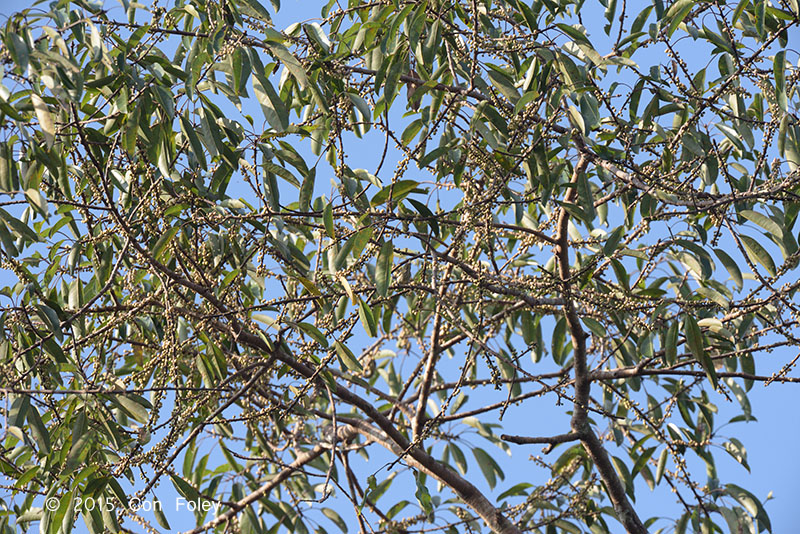In February 2012 a group of my regular birding friends and I came across a Sunda Fig that was in fruit and hosting a few Brown-backed Flowerpeckers.
This was a great find because the Brown-backed Flowerpecker is the rarest flowerpecker in peninsular Malaysia. Regular sightings are few, and perhaps under recorded since this species is a canopy dweller and feeder, and the canopy in a good rainforest can be 30 meters or more in height. Plus this rather plain brown bird might be mistaken for the female of other flowerpecker species. What truly made this an exceptional find was the fact that this fig tree was rather low and the flowerpecker came down to around 4-5 meters to feed and this afforded excellent opportunities to observe the bird. Altogether this Sunda Fig fruited three times in 2012 (Feb, Jul, Dec) and each time the Brown-backed came to feed.
It looked like birders worldwide would have an easily accessible spot to observe this species whenever the tree was in fruit. Then nature took its course and the tree was knocked down in a storm in late April 2013.
Irregular sightings of the Brown-backed occurred throughout 2014, but these were just random sightings, no regular fruiting tree was found. Until now.
On Feb 13 of this year I happened to be passing the area near the old tree when a lot of bird activity overhead caught my attention. I stopped the car and as the tree was rather high I setup my scope and started scanning the canopy. The tree was loaded with dark green figs, and the birds were going nuts. Little Green Pigeons, Blue-eared Barbets, Brown-Barbets, Asian Fairy Bluebird, bulbuls, leafbirds, … and then within just 5-10 minutes of viewing, BINGO, a Brown-backed Flowerpecker.
I have subsequently checked the tree on Feb 14, 25, 26 and yesterday, Feb 28th. The fruiting is still going strong and are ripening from dark green to cream-colored. It would appear the fruit will last at least another week, making the total duration of fruiting three weeks or longer. The bird activity is very high. Best time for viewing, 8-11 am. Interestingly the fruiting tree apparently attracts a lot of insects, certainly fig wasps, and the swiftlets are enjoying a bonus feast circling above the tree. There were 50 or more swiftlets circling overhead.
So with luck there will be regular spot for this species whenever this fig is in fruit. Although with all things in nature, it won’t last forever. Not sure what species of strangling fig this is, but it appears to have already killed the host tree and so a big storm could spell the end of its days. Unfortunately the tree is rather tall, about 35 meters, so you need a scope and photographic opportunities are challenging at best. The location of this tree is at the last stream crossing on Bunker Trail. This is about 500 meters from the entrance barrier to the oil palm estate.
We recorded 26 species yesterday, here is our list recorded on Feb 28th:
I have made subsequent visits on Mar 4, 6, 11 and Mar 14th. On each of those visits the tree was still being visited by an assemblage of birds and a few mammals. Added species include:
Rhinoceros Hornbill
Little Green Pigeon
Hill Myna
Hairy backed Bulbul
Rufous tailed Tailorbird
Dusky Leaf Monkey
Plantain Squirrel
Slender Squirrel
By March 14th the tree was only sparsely figging, yet a few birds were still coming in. I’ll mark March 14th as the practical end of the figging period, which was a full month from Feb 13th when first observed.
I have since made some progress in identifying the species of fig tree. It’s a Ficus caulocarpa which is a large deciduous strangling fig with a wide range at low elevations in SE Asia, Sri Lanka, Philippines, Indonesia, Taiwan, Japan and Papua New Guinea.
Here is a leaf, notice the long brown stalk connected to the yellowish midrib. This is characteristic of the species. The leaves can grow up to 18 cm long and 7 cm wide.
Here are some figs, notice they are small up to about 6 mm diameter. They grow in clusters of 2 – 4 on twigs but not on large branches. Cream colored with reddish spots.
Reference
A Guide to the Fabulous Figs of Singapore
See post about the Sunda Fig in 2012
http://confoley.com/brown-backed-flowerpecker
Suggested Reading
Native Fig Species as a Keystone Resource for the Singapore Urban Environment
Vertebrate assemblage at a fruiting fig (Ficus caulocarpa) in Maliau basin, Malaysia
Tags: birds, flowerpecker, Malaysia, Panti




